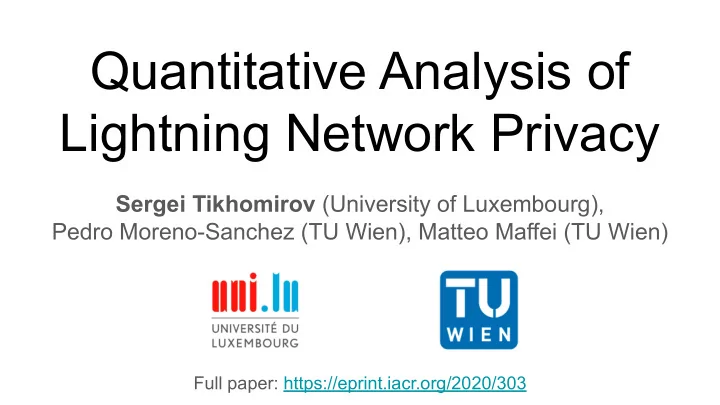

Quantitative Analysis of Lightning Network Privacy Sergei Tikhomirov (University of Luxembourg), Pedro Moreno-Sanchez (TU Wien), Matteo Maffei (TU Wien) Full paper: https://eprint.iacr.org/2020/303
Why Lightning? ● Bitcoin scales poorly (~3 tx / sec): all nodes validate all transactions ● Two approaches: on-chain (sharding) and off-chain (Lightning) We focus on the Lightning Network – a payment channel network for Bitcoin: ● Backwards compatible ● Deployed and used in practice (1000 BTC in 30k+ channels) ● New security and privacy challenges
Payment channel example Alice: 9 8 7 Bob Alice Bob: 1 2 3 ✔ : Alice, ❓ Bob Off-chain On-chain (Alice, Bob): 10 Alice: 7 Bob ⏰ : 3 Alice ⏰ : 10 ✔ : Alice, ✔ : Bob ✔ : Alice
Payment channel network ● Expensive to open channels between every two users (fees, confirmations) ● Solution: a network of payment channels ● Must ensure atomicity in multi-hop payments 101 coins 100 coins Alice Bob Charlie
Lightning Network architecture ● LN ensures atomicity with hash time-locked contracts (HTLCs) ● Coins go to Bob if he shows a hash preimage before time t, otherwise to Alice HTLC(100, h, t ₀ ) HTLC(101, h, t ₁ ) Alice Bob Charlie r r r h=hash(r)
Our contributions LN offers security (HTLC) and privacy (off-chain), but attacks have been reported. We all want LN to be secure and private, but what exactly does that mean? In this work, we: ● quantify the effect of three previously described attacks* ● analyze a limitation on payment concurrency ● describe a new DoS attack vector * Malavolta et al. Concurrency and privacy with payment-channel networks. CCS, 2017. Malavolta et al. Anonymous multi-hop locks for blockchain scalability and interoperability. NDSS, 2019.
Value privacy Attacker learns how much is being transacted. Trivial for on-path adversaries: amounts are in plaintext. Sufficient condition: 1 attacker’s node on the path. (103 sat, h, t ₃ ) (102 sat, h, t ₂ ) (101 sat, h, t ₁ ) (100 sat, h, t ₀ ) Alice Bob
Relationship anonymity Attacker learns who pays whom (with probability much better than random guess) Payments are linked by the same hash value. Sufficient condition: 2 attacker’s nodes on the path. (103 sat, h, t ₃ ) (102 sat, h, t ₂ ) (101 sat, h, t ₁ ) (100 sat, h, t ₀ ) Alice Alice Bob Bob
Wormhole attack Attacker “shortcuts” a payment, taking fee from the honest node. Damage for the honest node: a) no fees, b) capital locked until timeout expires. Sufficient condition: 2 attacker’s nodes on the path with honest nodes in between. (103 sat, h, t ₃ ) (102 sat, h, t ₂ ) (101 sat, h, t ₁ ) (100 sat, h, t ₀ ) Alice Alice Bob Bob (101 sat, h, t ₂ )
Experiment outline ● Assume that a certain subset of nodes is compromised ● Find all suitable paths between random sender and receiver ● Calculate the share of paths vulnerable to a given attack ● Average the result across many random runs VP RA WA Path 1 Safe Safe Safe Bob Alice Path 2 Prone Safe Safe Path 3 Prone Prone Safe Path 4 Prone Prone Prone Prone 75% 50% 25%
Results: highest degree nodes compromised
Countermeasures A trade-off between connectivity and privacy: ● Routing via large nodes: dangerous if they are compromised ● Routing via small nodes: less liquidity and uptime Bob Alice
HTLC limit How many concurrent payments can LN handle? ● One channel may hold multiple concurrent HTLCs ● Channel parties must be able to dispute malicious closures on-chain ● Dispute transactions include all in-flight (unresolved) HTLCs ● Bitcoin transactions must be < 100 KB ● Consequently, a channel supports at most 966 HTLCs ( HTLC limit )
Example of HTLC depletion Consider a channel with capacity of 1M sat. No HTLCs can be added, though capacity is not depleted. Unresolved HTLCs 1 HTLC (to Alice, 1000 sat, 0xdf86...) 2 HTLC (to Bob, 1000 sat, 0x0a1f...) … … 966 HTLC (to Alice, 1000 sat, 0x6f26...) Total value of HTLCs (sat) 966k < 1M Number of HTLCs 966
Up to 50% of channels affected Two limiting factors: capacity and HTLC limit. Depends on the amount: ● 0 – 546 sat (dust limit): no HTLC created ● 546 – 2700 sat (0.3 USD): HTLC limit is more important ● >2700 sat: capacity is more important
DoS by exceeding the HTLC limit ● An attacker blocks a channel by sending 966 near-dust payments ● Does not require as many coins as in the victim channel ● Can block a channel with 966*546 = 527k sat (~60 USD) Channel capacity (sat) Attacker’s capital for DoS Capacity-based HTLC-based 100k 100k 527k 1M 1M 527k 10M 10M 527k
Conclusion ● Privacy attacks are possible with only Alice Bob a few “important” nodes compromised ● Limited throughput for micropayments ● A new DoS vector Full paper: https://eprint.iacr.org/2020/303
Recommend
More recommend